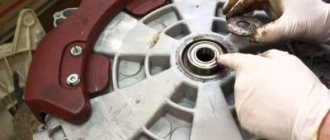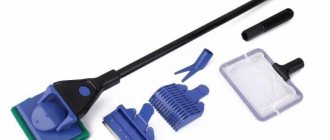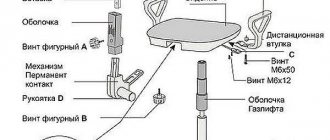Why does condensation appear?
Most often, condensation is formed from temperature differences. When there is cold water in the toilet tank, and warm, humid air outside (in the room itself). For moisture to begin to accumulate on the tank, the temperature difference must exceed 11-15 degrees.
The following reasons are also possible:
- increased degree of humidity in the toilet;
- presence of hot pipes in the room;
- drain malfunction;
- pressing the drain too often (then the accumulated water does not have time to reach a warm temperature).
Before fixing the problem, it is important to identify the exact cause.
The appearance of condensation on the tank: reasons
Most often there are two reasons: humidity in the bathroom and a large difference in temperature between the surface of the cistern and the surrounding air.
Condensation forms at the “border” of warm and cold air, so a difference of 12-15 degrees between the walls of the tank and the air environment is enough for moisture to form.
The following phenomena can be a source of increased humidity and differences in degrees:
- Lack of proper ventilation in the bathroom;
- pipe failure;
- riser in a room with constantly circulating water;
- hanging laundry to dry;
- malfunction of the shut-off valves of the tank, which causes increased water consumption;
- penetration of air with increased dampness from the street through cracks in door or window openings;
- defects made during finishing work: waterproofing of walls or ceilings that does not meet the standards, illiterate installation of double-glazed windows.
And also the primary source and reason why the tank “sweats” may be a combined bathroom with a bathtub.
Malfunction of tank shut-off valves
Condensation can accumulate on the surface of the tank due to the continuous flow of cold water because the drain mechanism is faulty. This leads to the filling and overflow of liquid into the toilet, thereby reducing the temperature on the surface of the walls of the tank due to cold water.
There is only one way out - repairing components or replacing all fittings. In addition to eliminating condensation, repairing the drain tank device will save a lot of water. This is especially important for users who have water meters.
What is condensate
In general, condensate is a water deposit that arises from the air and settles on various surfaces. As a rule, it appears due to a sharp change in temperature.
Often a similar phenomenon can be observed after taking a shower on the walls of the stall and other objects, but such moisture evaporates within a few minutes. But if thin streams of water constantly form on the toilet tank or pipes, this is a problem and certain measures must be taken to eliminate it.
Note! Condensation on the toilet tank is formed due to the influence of cold water (temperature 8-16 degrees) on the surface of the tank from the inside, as well as the influence of warm air flow (temperature 26-30 degrees) on the outer wall. Due to the large temperature difference, humidity increases and sediment appears.
Double wall cistern
Manufacturers of modern toilets are aware of the problem of condensation and offer their effective solution. The latest toilet models are being produced with an improved cistern design that prevents them from “crying.”
The double-walled cisterns of modern toilet models never sweat
In these models, an additional plastic container is inserted inside the tank, the walls of which do not come into contact with the ceramic surface of the product. As a result, its temperature is always constant and equal to room temperature. This constructive solution allows you to solve the problem once and for all. However, for many buyers, these models still remain inaccessible at a cost that is several times higher than the price of conventional toilets.
Some amateur craftsmen try to insulate the walls of the tank from the effects of cold water using heat-insulating materials that are glued to them from the inside of the tank. However, this technology does not completely solve the problem of condensation.
Some amateur craftsmen are trying to combat condensation on the tank by covering its inner walls with heat-insulating material
If you still can’t afford expensive “no-crying” models, then try installing forced ventilation. Even a simple fan, inserted into the ventilation window and turned on when the light is turned on in the bathroom, will solve the problem of condensation on cold surfaces. If the toilet cistern continues to sweat after this, call specialists to install more powerful ventilation systems.
Fittings for toilet cisterns in Moscow
Fittings for toilet cisterns and other products can be purchased at Leroy Merlin in Moscow at low prices. Select the product you are interested in on the website and buy it in our online store. The range of products presented in the catalog is extremely wide. Among them there will certainly be a position suitable in all respects.
All products presented in the section “Fittings for toilet cisterns” are produced by well-known companies that have proven themselves to be of high quality for their products.
You can always place an order and pay for it online on the official website of Leroy Merlin in Russia. For residents of the Moscow region, we not only have low prices for goods in the category “Fittings for toilet cisterns,” but also fast delivery to cities such as Moscow, Balashikha, Podolsk, Khimki, Korolev, Mytishchi, Lyubertsy, Krasnogorsk, Elektrostal, Kolomna, Odintsovo, Domodedovo, Serpukhov, Shchelkovo, Orekhovo-Zuevo, Ramenskoye, Dolgoprudny, Pushkino, Reutov, Sergiev Posad, Voskresensk, Lobnya, Ivanteevka, Dubna, Yegoryevsk, Chekhov, Dmitrov, Vidnoye, Stupino, Pavlovsky Posad, Naro-Fominsk, Fryazino, Lytkarino, Dzerzhinsky, Solnechnogorsk, Istra and Zhukovsky.
The tank leaks from the sides or from the bottom to the floor
Quite often, a tank leak is confused with the presence of condensation on its surface. Filling a container with cold water in a room at normal room temperature automatically causes dew drops to appear on the outer walls. It’s another matter when marks characteristic of a constant flow are visible on the sides. Rusty or calcareous marks left after water flow indicate a defect in the internal mechanism or cracks in the ceramic bowl itself.
Problems associated with the presence of traces of leaks can be classified as follows:
- presence of traces of water jets from technological holes;
- traces starting below the holes, appearing in places of microcracks;
- presence of traces at the bottom of the tank.
In the first case, when water simply overflows through the technological holes, the cause of the defect may be a malfunction of the overflow mechanism or the absence of a special hose attached to the filler pipe.
A fallen tube on the inlet pipe of the valve is not a critical malfunction; simply, under the pressure of water, a large amount of splashes with an unpredictable trajectory is formed in a confined space, as a result of which a certain amount of water simply splashes out. Flaw correction method:
- Shut off the water supply.
- Remove the cover.
- Place the fallen pipe onto the pipe and secure it with a clamp.
If the ceramic or plastic bowl of the tank is mechanically damaged, a leak may occur on the walls at the fracture site. It is useless to repair visible cracks that threaten the integrity of the structure; the constant process of filling and draining water systematically affects the walls and breaks the seam, no matter how strong it may be. In this case, you just need to replace the tank.
If no visible cracks are visible, but water seepage still occurs, it is recommended:
- Shut off the water supply.
- Drain the water from the tank.
- Mark places where water leaks.
- Dry the tank outside and inside.
- Using silicone sealant or silicate glue, treat microcracks inside and outside the walls.
- After finishing the treatment, fill the tank with water.
Filling microcracks with sealing compounds will ensure sealing of the walls for a fairly long period, but this is provided that the walls are not subject to mechanical stress that can turn microcracks into real faults.
Tanks with bottom hose connections most often leak at the hose connection. The defect can be eliminated by tightening the hose nut on the fitting or removing the hose and reinstalling it using fum tape or tow.
Why does condensation appear on the toilet tank?
It is harmful to health when the air in the apartment is dry, but high humidity also leads to not very good consequences. This may also cause the tank to sweat. This often occurs where clothes are dried indoors, there is a large aquarium, or lovers of indoor flowers, trying to create conditions for their green pets that are close to natural, constantly spray them.
The most common cause of condensation is high humidity in the apartment.
These reasons can be easily eliminated - you can install air dehumidifiers or take the laundry out to the balcony after washing. It is more difficult when there are leaks in the plumbing or heating systems, or ventilation does not work well. The most common reason is the continuous flow of water at a low temperature due to problems in the design of the drainage device or due to frequent drains. Condensation in these cases is the result of contact of warm room air with the constantly cooling surface of the drain tank.
Malfunctions of the interior of the toilet and their elimination
If water, even in a thin stream, flows freely into the toilet, then its volume in the tank must be continuously replenished. Hence the droplets of water on the surface and large water bills. The solution to the problem is to eliminate the leak. Sometimes replacing a worn rubber siphon membrane helps:
- drain the water completely from the tank;
- fix the lever in such a position that the hole is closed with a valve and no more water flows in;
- dismantle the siphon by disconnecting it from the lever;
First of all, you should eliminate possible tank leaks, if any.
- remove the worn membrane and replace it with a new one;
- return the siphon to its place and secure it;
- perform a test drain.
The reason may also be hidden in a faulty float, then perform the following actions:
- remove the float from the tank;
- pour water out of it;
- let dry;
Float repair
- seal the hole through which water enters;
- are installed in place.
If it is possible to buy a new float, then this option is better, because... the repaired part will still not last long. The problem can be solved even easier if the leak occurs due to the incorrect position of the float; to eliminate it, simply open the reservoir and return the lever to its normal position.
Work technology
When you have a cast iron sewer pipe in front of you, the next step is to fix the shut-off valve to the flange outlets of the saddle. The crown will be inserted through the first one. The cast iron pipe is drilled, and it will be necessary to cool the work site and replace broken bits from time to time. In this case, you need to use a special cutting tool that has carbide plates. It will be impossible to cut the material using other equipment. At the final stage, the crown is removed, the water flow is blocked, and the installation of the external branch is carried out according to standard rules.
Troubleshooting
First of all, you need to check how well the tank itself is functioning. The technology for performing such work is not particularly difficult. To do this, you need to observe a little how the mechanism carries out its functional tasks.
When the toilet is not in use, but water still flows from the tank, even if it flows in a small stream, the drainage system needs to be repaired. Such a leak can be determined by the formation of a trace of water, which appears inside over time.
To eliminate the malfunction, you will need to check every part of the device , paying special attention to the connecting elements and inlet fittings. If it is not possible to cope with the task yourself, it is better to use the help of a specialist who can perform both diagnostics and troubleshooting. Calling a plumber is an ideal solution for users who do not have enough knowledge and practical experience to get rid of a plumbing problem. The repair will eliminate the problem and solve the issue with the wet surface of the tank.
If the problem is that the toilet is used too often, then installing a two-stage button on the mechanism can help. The latest models of plumbing fixtures are initially sold in this configuration. The button can be easily purchased at any construction supermarket; the cost of the product is quite affordable for most consumers.
By installing a button, it becomes possible to drain only a certain part of the water contained in the toilet tank. The button is a system that consists of two drain modes - full and partial. This feature makes it possible to save water, which is important today for most owners of apartments and houses, and also allows the incoming liquid to warm up over time. This will reduce the likelihood of moisture forming on the surface of the toilet.
Other ways to eliminate condensation
Never a sweaty toilet
Not long ago, toilet models with a two-piece tank appeared on sale. The water in it is in an internal plastic tank and does not come into contact with the walls of the main vessel, therefore, condensation does not form. The solution is ideal, but the cost is confusing - it is several times higher than that of a toilet with a traditional tank.
Construction of a two-piece toilet cistern
Minimizing waste
The smaller the volume of water that goes down the drain, the greater the chance that there will be no condensation. There are toilets with a cistern equipped with a two-button mechanism. When one button is used, approximately 5 liters of water flows out of the tank, the other - about 7 liters. And in tanks with an Aquastop drainage system, one control button is built into the lid: with one press, water begins to pour out, and with a second press you can stop this process.
Two-button mechanism for flushing water
Insulation of the cistern
Some craftsmen independently isolate the walls of the tank from interaction with cold water. The modification is as follows:
- Turn off the water supply.
- Disconnect the hose through which water flows.
- Remove the drain tank.
- Dismantle everything inside the tank.
- Rinse the container and wipe dry.
- Cut out the liner from the insulation. To do this, lay it out on a flat plane, place the tank on it in the same position as it usually stands in the working position, trace the bottom around the perimeter, and then cut out the workpiece.
Tank drain device - Place the workpiece inside and press tightly.
- Measure the height of the walls from the inside, starting from the liner and ending with the top edge of the tank. Subtract about 3 cm from the resulting size.
- The perimeter of the walls is also measured from the inside, and an allowance of about 100 mm is added.
- Place the pattern inside. The joint is overlapped, so carefully pressing the workpiece against the walls, make a through cut in this place. Take out the workpieces.
- Perform assembly:
- apply sealant to the bottom, around the holes for installing fittings;
- put the bottom in place;
- insert the inner liner, having previously applied glue to the sides;
- fill the vertical joint with silicone;
Insulated cistern
- treat the joint between the bottom and side walls with sealant;
- Allow at least a day to dry, cut holes for the reinforcement, and apply sealant to the edges;
- put everything in place.
Tip: to insulate the tank, you can use neoprene, foamed polystyrene and other materials.
Here are the main causes of fogging in the toilet tank and how to eliminate them. If you cannot eliminate condensation yourself, contact a professional.
How to get rid of condensation on a toilet tank: video
https://youtu.be/p8iH0UvDCOg
Reasons for the appearance of condensation on the tank: photo
When to eliminate and when to ignore
You can ignore the problem only in one case. If the tank begins to fog up slightly, but dries quickly. And the presence of condensation on the toilet is almost invisible. If the toilet has time to dry before your next visit to the toilet, you can ignore it. There is no threat to the floor or other surfaces.
A striking example of fogging of the toilet cistern
If there is always fogging on the tank and nothing evaporates on its own, you need to act. And that's why:
Water that flows onto the floor creates puddles. It's inconvenient and not aesthetically pleasing. I have to constantly wipe the floor.
This ruins the finish. Moisture destroys many surfaces. Floors and walls quickly lose their attractive appearance.
The volume of condensate may increase. Then there will be not just puddles on the floor, but a whole lake. There is a risk of flooding your neighbors.
Water droplets penetrate small cracks and other unprotected areas. Gradually, the water accumulates and stagnates. An unpleasant musty smell appears in the room.
Condensation increases the level of humidity in the room. Especially in combined bathrooms. When humidity is high, mold and other fungi grow in the house. This spoils the appearance of the bathroom, destroys the walls and causes an unpleasant odor. In addition, mold is dangerous to human health. Frequent headaches, allergies, decreased immunity - all this can appear due to fungi.
Small cracks will appear on the tank. With time. Continuous exposure to moisture affects any material. By the way, mold can also grow in cracks.
Wooden elements will begin to rot. Parquet, furniture, decorative items - everything is at risk.
Rust will appear on metal parts. And there are a lot of them in bathrooms: from water pipes to small items.
You may have to throw away the mirror. Because with high humidity, black mold often forms behind it. It is impossible to withdraw.
Thus, condensation worsens the indoor microclimate and damages surfaces. The lifespan of the repair will be reduced to approximately four years. Then you'll have to make a new one.
Why does the toilet cistern sweat?
Condensation on the toilet cistern appears due to the fact that the water temperature in it differs from the air temperature in the room by an average of 15 degrees . This is why the surface begins to “sweat”. Water enters the toilet from a pipeline that is located on the street or underground; if it is winter and the room is heated, then the difference will be huge.
The appearance of condensation may occur due to the following factors:
- water leakage - appears due to malfunction of fittings when the tank begins to fill with cold water. In this case, condensation forms regardless of the water pressure, but it determines how much the tank fogs up. To get rid of condensation formed due to leakage, you need to adjust the drainage system or replace faulty toilet parts;
- excessive water consumption - the more often the toilet is flushed, the more cold liquid enters it. Accordingly, the likelihood that the surface will fog up will be higher. To solve this problem without compromising the cleaning of the toilet bowl, you need to adjust it so that less water is supplied. If your family is large and you have to use the toilet often, it is better to purchase a toilet with a stepped or adjustable flush. This will significantly reduce the use of liquid and can rid the tank of condensation;
- the water is too cold - if you live in a private house, you can additionally insulate the water supply line, this will slightly heat the water when supplied and reduce the likelihood of condensation appearing on the toilet tank;
- increased humidity in the bathroom or bathroom - to cope with fogging of the tank when the air humidity in the toilet is high, install dehumidifiers;
- problems with the ventilation system - if they exist, then the air masses will not be able to escape efficiently, and accordingly, this will lead to the appearance of condensation. For example, the quality of ventilation deteriorates significantly if the holes are tightly lined, so we do not recommend doing this in places of high humidity.
Ventilation
Sometimes the cause of condensation accumulation is not the plumbing mechanism itself. The question may concern other issues, for example, high humidity levels. This phenomenon is often the root cause of moisture accumulation on the outer surface of the tank.
Proper arrangement of ventilation in the bathroom and toilet will help not only get rid of fogging of various devices in these rooms, but also optimize the microclimate throughout the home.
The first step is to resort to installing a fan with good power , which is installed in a circular slot in the wall. Nowadays, many types of ventilation devices can be easily connected to light switches in the room, thanks to which they will carry out their work when the lighting in the bathroom is turned on. Moreover, installation related to lighting can also be carried out in the reverse mode of fan operation - that is, the mechanism will begin to supply fresh air when the lights in the room are turned off. In light of the fact that ventilation devices still make noise during operation, models that will work when the lighting is off are more in demand.
In order for ventilation to help reduce moisture levels and ventilate, certain door models are often installed in bathrooms and toilets, which have special grilles or holes for air circulation. Such design features of door panels provide free exit for humidified air from the room, which, in turn, quickly mixes with the general microclimate in the apartment.
It would not be amiss to additionally clean the ventilation ducts leading to the bathroom; the air exchange in the home also depends on their condition. Lack of traction will indicate that the channel is clogged.
Another factor influencing the operation of general ventilation in an apartment may be covering the window with some material. The plug must be removed since ventilation in the bathroom is mandatory. In the early days, after acquiring living space, this factor could simply not have been paid attention to. However, it can cause a number of unpleasant phenomena in the future, among which the main ones are condensation, fungus, unpleasant odor in the room, and corrosion of water pipes.
The hole is sometimes sealed, guided by the aesthetic component , when the window for ventilation does not meet the owners’ requirements in appearance. But today there are many options for beautiful ventilation grilles on sale that will allow you to give this essential component a more neat look that does not attract unnecessary attention.
Methods for dealing with condensation
As mentioned earlier, methods of dealing with condensation depend on the cause of its occurrence . Let's look at the most common ones:
- check the ventilation - as already mentioned, it is undesirable to completely seal the ventilation holes in order to “cultivate” the room. It’s better to buy a decorative grille, it also looks great, and there will be no problems with ventilation in the toilet. Another way to solve the ventilation problem is to leave the toilet door slightly open, but this is not possible in all cases;
- installation of forced ventilation - this solution is perfect for combined bathrooms, when condensation appears not only on the toilet, but also on tiles, mirrors, ceilings and other coatings. In such cases, it is better to install a professional ventilation system with a power that would correspond to the conditions of use of the bathroom in a particular case. Then condensates will stop appearing;
- fixing the drainage device - if the drainage tank is broken, water will constantly flow from it. Naturally, it is cold, as a result of which the surface of the tank will also be cold and fog up. In addition, if you have a meter, then with such a problem you will also have to pay for such a leak. If you have the appropriate skills, you can fix the problem yourself or call a plumber;
- installation of thermal insulation on the tank and pipes - for this, both special insulating devices and improvised means are used. In order to insulate the tank, you need to wipe it dry, then cover it with thermal insulation using a special adhesive. Expanded polystyrene sheets or neoprene can be used as insulation. However, this method is not always able to completely rid the tank of fogging.
By the way, some toilet manufacturers offer models with double-walled flush tanks; such tanks have an additional plastic container on the inside that does not come into contact with the ceramics. If your model does not provide this option, you can put a plastic insert there yourself.
In addition, many also recommend methods of combating tank fogging, such as:
- installation of heated towel rails;
- installation of a special boiler.
Experts still believe that the most effective method of dealing with condensation is a professional ventilation system , which is capable of maintaining the most optimal level of humidity in the room, at which the appearance of condensation is reduced to zero.
As you can see, it is possible to deal with a sweaty toilet tank, just like with walls and mirrors, and there are plenty of ways to do this. If it is not possible to purchase and install a powerful professional ventilation system, then try to ventilate the bathroom more often, monitor the condition of the plumbing, and do not ignore the appearance of condensation or puddles in the toilet. If you follow this, then such a problem as fogging of the tank will disappear, and your plumbing fixtures will last for many years, and visiting the toilet will be as pleasant as possible.
How to get rid of condensation on a toilet tank
If your plumbing becomes foggy, you need to take appropriate measures. Resolving the problem depends on its cause.
Condensation on the toilet cistern in a private house
Many owners take only temporary measures, for example, placing a piece of cloth under plumbing fixtures or installing a vessel to collect water. However, such methods can only aggravate the problem.
In most cases, condensation collects on the toilet tank due to temperature differences. For example, if it is at least 10 °C, drops of water will definitely appear on the surface of the plumbing fixtures. And they also note that the toilet tank in the toilet sweats with frequent use. You can adjust the fittings, which reduces the amount of incoming water.
Attention! If you frequently use plumbing equipment, it is recommended to purchase a product with a stepped drain. Some toilets are equipped with a two-button mechanism designed to drain water.
Usually, owners of private houses are recommended to additionally insulate the water supply. A simple method involves supplying heated water to the tank.
Hot water is harmful to fittings
What to do if the toilet sweats from cold water
To eliminate this unpleasant phenomenon, you can use methods of insulating plumbing from the inside and thermal insulation. For example, the use of polyurethane foam leads to a reduction in the volume of the tank. However, cold water in this case does not come into contact with the walls.
To get rid of condensation in the toilet, they also use insulation, which is a layer of foil.
Over time, wet material may fall off and then clog the valves of the product.
Heavy condensation on the toilet cistern and pipes
Sometimes, to fix the problem, it is advised to lower the temperature in the bathroom. This can be done by adjusting the heating power.
If the toilet cistern in the bathroom fogs up, you must first make sure that the ventilation system of the room is in good working order and intact. For this purpose, bring a candle, paper or lighter to the ventilation grille. The flame should burn evenly. A properly functioning system is also indicated by paper sticking.
Attention! If the flame goes out and the paper falls, take appropriate action. Adequate ventilation must be restored. The toilet tank often condenses when the float mechanism and shut-off valves break down
The malfunction leads to a continuous flow of water from the sewer pipes. At the same time, she does not have time to defend herself. The movement of cold water flows causes condensation to appear. And usually modern products do not require repair of individual parts
The toilet tank often condenses when the float mechanism and shut-off valves break down. The malfunction leads to a continuous flow of water from the sewer pipes. At the same time, she does not have time to defend herself. The movement of cold water flows causes condensation to appear. And usually modern products do not require repair of individual parts.
In the event of a breakdown, you need to purchase a set of shut-off valves
How to eliminate condensation on a toilet tank
There are different ways to remove condensation from a toilet tank. Sometimes drastic measures are needed, but your own comfort and health are much more expensive.
Check ventilation ducts
The formation of condensation on the drain tank and pipes is often associated with poor ventilation. The cause of the trouble may lie in its clogging or complete absence. If there is no ventilation, then it needs to be organized. This may be an exit to the next room or upstairs when there are no more residential floors. It is easier to solve the problem in a house with wooden floors and an attic - just make a hole of a suitable size in the ceiling and bring out a long pipe.
If there is ventilation in the bathroom, but condensation forms, then you should check its condition. This can be done using a lighter, match or candle. The flame source must be brought directly to the vent. If traction is weak or absent, cleaning is necessary:
- removing and washing the grill;
- removing debris from the ventilation duct;
- removing deposits from the walls - a narrow spatula, scraper, or brush will help (there are devices of different diameters with a flexible shaft on sale);
- vacuuming - do not use attachments, only a tube (hose);
- wiping the walls and bottom of the channel with a damp cloth.
If you can’t clean the ventilation yourself, you can contact the management company or professionals who have the appropriate license for such work.
One solution to the problem is forced ventilation; the device must have increased protection from moisture
Raise the water temperature
The reason for the formation of condensation on the toilet tank lies in the temperature difference, so it can be increased from the inside. There are several options:
- insulating the pipe - this method is effective if it is enough to raise the water temperature by 2-3 °C;
- supplying hot water to the tank, this option is appropriate if its temperature is always low and there is no meter;
- organizing a heat exchanger if there is a heating riser nearby;
- supply of warm water, you need to install a tee and mortise ball valves.
Most of the methods listed are appropriate for eliminating condensation on a toilet tank only in a private house with its own water supply. In an ordinary apartment, meters are installed, so utility bills will only increase.
To organize a heat exchanger, you need to wrap a copper tube around the heating riser 5-6 times and cut it into the water supply to the toilet. The homemade coil needs to be insulated. You can use mineral wool or other material.
Improve the tank
You can get rid of condensation on the toilet tank by upgrading it. One option is insulation inside. For this you can use different materials:
- Styrofoam;
- foamed polyethylene;
- Isover.
You should use insulation no thicker than 1 cm. Otherwise, the internal volume will be too reduced.
Work algorithm:
- Shut off the water supply.
- Thoroughly clean the inner walls and bottom of dirt, rust, and limescale.
- Dry the surface.
- Glue the insulation, treat all joints with sealant.
- Wait for the glue to dry.
- Cut holes for shut-off valves.
- Install fittings and configure.
- Turn on the water supply.
Advice! To insulate the toilet cistern, you can use polyurethane foam. Apply it in several stages, after complete hardening, cut off the excess, leaving a layer of no more than 1 cm.
To insulate the toilet cistern it is convenient to use self-adhesive materials
One of the options for protecting the toilet cistern from condensation is the use of glass microspheres (microballs). It is a composite material with good adhesion. It can be mixed with sealant and applied to the inner walls of the tank. A layer of 3 mm is enough. The mixture must dry completely - the time is indicated in the instructions for the sealant.
You can also insulate the toilet tank from the outside to protect against condensation. The disadvantage of this option is that it is unattractive, but the advantage is that it preserves the internal volume.
Another option for upgrading the toilet tank to protect against condensation is to install a plastic tank inside. Thanks to it, cold water will not come into contact with sanitaryware. There should be a distance of 2-3 mm between the inner walls of the toilet cistern and the tank. This gap is filled with rubber or silicone gaskets.
A drastic measure to combat condensation is to purchase a new double-walled tank. It is usually sold only complete with a toilet.
Insulate the toilet
Insulating the toilet helps get rid of condensation on the toilet tank by reducing the level of humidity in the bathroom. This option is costly, but allows you to provide a comfortable microclimate in the room. This is appropriate for combined bathrooms.
You can insulate only the floor or walls individually or the entire room. There are several material options for this:
- cork agglomerate;
- polyurethane foam;
- Styrofoam;
- penoizol;
- extruded polystyrene foam;
- warm plaster;
- mineral wool.
Before insulation, you will have to remove the old finish. Surfaces must be treated with an antiseptic. If there are large differences or cracks, they need to be repaired.
If major repairs are necessary, heated floors can be installed. This will not only solve the condensation problem, but will also increase the level of comfort in the room.
Fix the drain
A leaking toilet tank means that the liquid in it does not have time to warm up. Sometimes a malfunction is difficult to notice, especially with regular cleaning of plumbing fixtures, which prevents the characteristic trace of water from remaining.
Repairing a toilet tank may involve adjusting the flush or replacing a failed part. This could be a float, a shut-off valve, or a seal. The repair features depend on the design of the tank.
Reduce water drainage
You can combat condensation on the toilet cistern by reducing the flow of water. In this case, the new portion of cold liquid will be smaller, and mixing with the warmer residue will provide sufficient temperature. There are two ways to reduce drainage:
- Double button with minimum drain function.
- Adjust the drain yourself with a light press of the button. This option does not always work, especially if you have small children.
A double button can be installed on an old tank, but you will have to replace all the fittings
How to get rid
The problem can be resolved in different ways. We offer you 7 proven solutions.
Change the microclimate in the bathroom
If poor ventilation is to blame for the increase in humidity levels, then you need to take care of changing the microclimate.
What to do:
- Ventilate the room. If there is a gap between the floor and the doors, air will leak through it.
- If there is no gap, you need to check the ventilation duct. You can use a match/lighter for this. If the draft is weakened, it is necessary to clean the ventilation shaft.
- If cleaning the ventilation shaft does not produce results, you need to install an exhaust ventilation device. If the bathroom is combined, you should choose models with increased protection from moisture.
- Install an air dryer. This is a device that collects water molecules from the atmosphere. The larger the room, the larger the device should be.
- Install an air conditioner. The air conditioner will bring the temperature of the air around the toilet closer to the temperature of the water in the tank. Will reduce moisture content in the air.
If the bathroom is combined, it is useful to use an exhaust fan while taking a shower. It is turned on a few minutes before water procedures and left for 10-15 minutes after them.
The time you take a shower or bath should be reduced. Afterwards, wipe the glass curtain, bathtub, and walls. Excess moisture harms the microclimate. The water on the walls will evaporate into the surrounding atmosphere and condense on the toilet.
Raise the water temperature
The goal is to reduce the difference between the temperature of the water in the tank and the air in the room to reduce the formation of condensation on the tank.
What can be done:
- Insulate the pipeline. This will increase the temperature of the water in the pipes.
- Connect the hot pipeline to the tank. Instead of cold. Important: This may increase your utility bills.
- Install a boiler. Water heating system.
- Make a heat exchanger. For example, using a thermal riser.
You can install a half drain. This will dilute the cold water with warmer water.
Modernize the cistern
Modernizing the drain tank will also have a positive effect on the degree of condensation formation. What should be done:
- Insulate it. From the inside. This is done with polystyrene foam, polyethylene foam or isover. The main thing is to remember to turn off the water before starting work. And drain all the liquid from the tank. The slightest dirt is removed from the walls. Brush, sponge, cleaning agent. Remove rust from the inside and bottom.
- Place a second plastic tank inside the tank. The distance between both is 2-3 mm. Rubber gaskets are placed in the gap. Can be silicone.
- Install a new toilet. The new ones are equipped with condensation protection. They have a double tank - made of earthenware and plastic. Such toilets are not cheap, but they are reliable and last a long time. There are also quenching tanks. The cold water line is fed into a separate tank, which heats the water before it is sent.
- This job requires open access to the waterline and sufficient space for the reservoir, among other complications. You will almost certainly have to hire a professional to do the installation.
An example of insulating a toilet cistern with foamed polyethylene
The insulation layer should have a thickness of up to 10 mm. Otherwise, the volume of the tank will decrease.
Insulation inside the tank protects the porcelain surface from cold water. This allows the tank to be in the same temperature range as the rest of the room. Significantly reducing the degree of condensation.
Insulate the toilet
Insulating your toilet can reduce the overall humidity level in the room.
This will also improve the microclimate in the bathroom. You can insulate both the floor and the walls. And all together.
Make a double wall
Double wall toilet cistern
A double wall inside the tank is one of the most effective solutions.
A plastic reservoir can be placed inside the main tank. Plastic transmits heat better. Therefore, the water will warm up faster and the formation of condensation on the tank will be minimized. As stated above, you can immediately buy a new double-wall toilet. Then the temperature of the water in the tank will always be approximately the same as in the bathroom.
Fix the drain
If the tank leaks, the water in it does not have time to warm up to the required temperature. Same with other problems. Breakage of the shut-off valve and seal, wear of the bulb - all this contributes to the fact that the contents of the tank are regularly drained into the sewer. This also provokes the formation of condensation. Up to 1.5-3 liters per day.
Therefore it is necessary:
- repair or replace non-functioning components;
- remove limescale;
- replace the seal.
It is important that the drain does not touch the walls of the tank.
Do not drain the water completely
The more water is drained, the more is collected again. The incoming water is cold and does not have time to warm up completely. If you do not drain completely, there will be less new cold water.
To reduce drainage, two ways are suitable:
- Use a button with a minimum drain function. It is found on many modern toilets.
- Reduce drain pressure. For example, pressing a button very lightly.
- Adjust the drain valve so that pressing the button does not cause a complete flush.
There is an alternative option - visit the bathroom less. If you are a man, go to the sink, and the ladies will be patient.
Thus, condensation forms when warm, moist air hits a cold surface. A similar mechanism is observed in drinks with ice, when the walls of the glass fog up due to temperature differences. In the bathroom, a similar effect is eliminated by regulating the temperatures in the tank and in the surrounding atmosphere. The smaller the difference between them, the better.
How to get rid of the problem
After detecting sediment, it is recommended to study information on how to get rid of it. There are several ways to fix the problem, depending on why condensation collects on the toilet tank in a particular case.
Change of microclimate
If the cause of the increase in moisture is a ventilation malfunction, you will need to get rid of disturbances in the microclimate of the room, in particular, the use of specialized devices.
Let's determine what needs to be done if condensation on the toilet cistern occurs due to problems with the microclimate:
take care of forced ventilation of the room. If there is a small gap under the door, air will flow through it. If it is missing, it is recommended to check the operation of the ventilation duct (this can be easily done with a match or lighter). If there is no sufficient draft, it is necessary to clean the ventilation shaft. If this does not help, you will need to install an exhaust ventilation device. When choosing such a device, it is advisable to focus on the type of toilet. If it is combined, then you should opt for a fan model with improved protection against moisture and water splashes;
install an air dryer. This device will collect water molecules in the air and localize them in a separate container. The device operates based on the readings of the built-in hygrometer. When choosing, you should consider the size of the bathroom.
Such actions in most cases lead to the prevention of a situation where condensation accumulates on the toilet tank.
Increase in water temperature
As mentioned above, sediment is formed due to a temperature difference of approximately 15 degrees between the water in the tank and the temperature in the room. Therefore, in order to get rid of sediment, it is necessary to minimize the difference by increasing the temperature of the working fluid in the container.
Let's determine what needs to be done if condensation collects on the toilet cistern due to this reason:
- insulate the pipeline (this will increase the temperature in the pipes by several degrees). Ready-made material for this is sold in many construction stores;
- connect the hot water supply to the tank instead of the cold water supply. However, it is advisable to do this only in the absence of an appropriate meter, otherwise the costs of water consumption will be very high;
- install a boiler system;
- create a heat exchanger using a thermal apartment riser;
- install a half-flush system, which will ensure dilution of already heated water with cold water.
Tank modernization
How to deal with condensation on a toilet cistern:
- insulation of the tank from the inside;
- placement inside a special plastic tank. The distance between the inserted plastic container and the tank should be 2-3 mm. Gaskets made of silicone or rubber are installed in a small gap.
- dismantling the toilet and installing a more modern model, the tank of which is protected against condensation. Such models have a double tank with a plastic and earthenware container. This option is the most expensive, but cost is the only drawback of such toilets.
Internal insulation of the container is carried out using polystyrene foam, tepofol, foamed polyethylene and other heat-insulating materials
It is important to completely turn off the water and completely remove any remaining liquid from the tank before starting the procedure. The procedure may also require glue and a sealant. When choosing a material, it is recommended to purchase a layer with a thickness of up to 1 cm so that the working volume of the tank does not decrease
After gluing the insulation, it is necessary to treat the joints with sealant. When it hardens, you can cut holes for installing plumbing fixtures
When choosing a material, it is recommended to purchase a layer with a thickness of up to 1 cm so that the working volume of the tank does not decrease. After gluing the insulation, it is necessary to treat the joints with sealant. Once it has hardened, you can cut holes to install plumbing fixtures.
In some cases, polyurethane foam is used for insulation. It has excellent thermal insulation properties, but involves a more complex process. It is advisable to apply the foam in 4 stages to ensure uniformity.
Then you will need to wait some time until it hardens completely, after which you can cut off the excess part. For high-quality insulation, a layer one centimeter thick is sufficient.
Looking for an answer to the question - what to do if the toilet tank sweats?
A modern person places certain demands on the toilet; it should be comfortable, beautiful and, of course, clean. And suddenly a problem arises when, it seems, all measures have been taken to create a comfortable and aesthetic closet: the water supply and drainage system has been replaced, and a new toilet has been installed, but moisture collects on it. And not just on the pipes, but on the tank, which, in theory, should serve without any interference.
If condensation has formed, you should not immediately run to the store and demand an exchange of the product; first, you should make sure that “comfortable” conditions have been created for its operation











